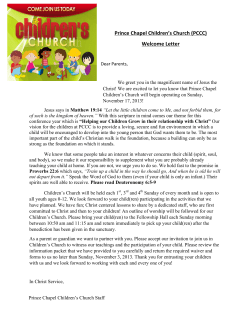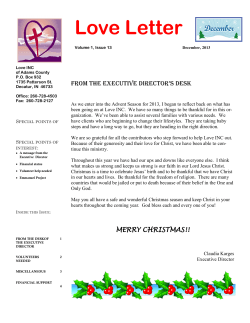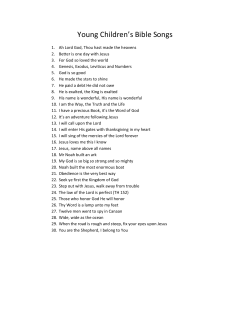
From The Southern Baptist Journal of Missions & Evangelism, Vol.... 6-10. For more information, visit www.sbts.edu/bgs/sbjme.
From The Southern Baptist Journal of Missions & Evangelism, Vol. I, no. 3 (Spring 2013): 6-10. For more information, visit www.sbts.edu/bgs/sbjme. My Hope with Billy Graham: A Theological Affirmation LON ALLISON, TIMOTHY K. BEOUGHER, ALAN MYATT, AND MICHAEL A. MILTON Lon Allison is the Executive Director of the Billy Graham Center at Wheaton College, Wheaton, Illinois. Timothy K. Beougher is the Billy Graham Professor of Evangelism and Associate Dean of the Billy Graham School of Missions and Evangelism at The Southern Baptist Theological Seminary, Louisville, Kentucky. Michael A. Milton is the Chancellor and Chief Executive Officer at Reformed Theological Seminary, Charlotte, North Carolina. Alan Myatt is the Professor of Theology and Missions at GordonConwell Theological Seminary, Charlotte, North Carolina. “Daddy thinks the Lord will allow him to live to 95.” I t was not a prophecy but a hope. A hope, Franklin Graham explained, that was not merely about his father’s desire to live to see a milestone of four score and fifteen years of age, but to live to see the beginning of a Christian renewal, and if God would so allow, a genuine heaven-sent revival in America. This past April (2012), the Billy Graham Evangelistic Association invited pastors, theologians, and evangelical leaders from across the nation to a meeting to unveil a new outreach emphasis called, “My Hope with Billy Graham.” Franklin Graham’s introductor y remarks and Billy Graham’s passionate plea that followed removed any cynical thoughts in the room that this might be a “send off ” campaign for Billy Graham before he went home to heaven. The old gospel warrior’s words, pauses, inflections, and yes, even 6 his aged faintness of voice all carried urgency and an unmistakably genuine, passionate concern that North America needed a powerful movement of God if we were to survive as a people. We have been to several “Christian campaign kick-offs.” This one was different, not just because those of us who were blessed to attend got to hear his burdened plea for revival in an intimate setting at the Billy Graham Library in Charlotte, North Carolina, but because here was a man of God who was as committed to the Great Commission of Jesus Christ in 2012 as he was in 1949.1 He acknowledged that revival was God’s business. Yet he also focused on the mandate of the Great Commission, the response of love, and the hope we have in Christ2 -- to intentionally proclaim the Cross of Jesus Christ to this generation.3 He told us that the increasingly complex problems we were facing called for a powerful movement of Christ. Then he began to warn that SBJME 1.3 | SPRING 2013 unless revival comes -- beginning with the Church mobilizing to intentionally pray for the lost, share Christ and seek God -- there is no way out. In that moment, as this elderly grey haired man in the wheelchair spoke, I (Michael Milton) was no longer a minister and a seminary leader in a prestigious gathering with a veritable living chapter in the pages of Church history. I was an orphan boy from Louisiana on the edge of my seat at a football stadium and my heart was gripped by the simple, unforgettable, spiritually charged moment when I knew I was a sinner, that Hell was real, and that repentance and faith in the resurrected and sooncoming Jesus Christ was the only hope. It wasn’t supposed to be personal, but that meeting, this article, and almost any interaction with the great evangelist of our age turns personal. Some of us believe that all theology is personal, so I will not apologize. Yet my role, with colleagues and coauthors from other academic institutions associated with Billy Graham,4 is to introduce what we believe is a significant opportunity for the renewal and mobilization of the Church in our day. My Hope with Billy Graham is described as an “effort to reach people across the United States and Canada with the Gospel of Jesus Christ. Following a simple Biblical model, My Hope combines the reach and excitement of a nationwide media event with the power of personal relationships.” 5 This BGEA ministry seeks to work through local churches, seminaries, and other ministries, to equip their constituents to intentionally join in this continent-wide effort to “invite, watch, share, and ask.”6 BGEA has produced a series of materials that can be used in training believers to invite others to an informal, hospitable setting -- a home, a coffee shop, or another meeting place -- to see/hear conversion testimonies and a gospel presentation by Dr. Graham. The believers who see persons respond to the gospel message are asked to follow through with discipleship in their own churches. As we have considered this ministry and reflected biblically and theologically about its meaning and potential for the North American Church, we have sought to be careful to think through what it is not. We have not found My Hope to be associated with revivalism or Finney-like7 techniques to try and “create” revival. Billy Graham and the other leaders of this movement have been clear that this emphasis is about the Great Commission, not presuming upon God for what “only He can do.”8 Nor do we believe, as suggested earlier, that My Hope is a celebration of the life and ministry of Billy Graham, however deserving such a program might be. My Hope has demonstrated, from Dr. Graham’s own charge to his staff and his assurance to those of us who were at the unveiling of the ministry, that this is about the local church, not the aggrandizement of a particular ministry (though supporting The Billy Graham Evangelistic Association for such a magnanimous Kingdom-focused effort seems Biblically appropriate). Promotion of one man or his ministry is not the aim of this outreach opportunity. In the following paragraphs we will highlight the basic Biblical values that we have found in My Hope and commend them as those essential elements of the Great Commission that transcend denominations and historical theological positions along the evangelical spectrum. Throughout his ministry, Billy Graham has proclaimed God’s Word with conviction and passion. The phrase, “the Bible says,” resounds throughout his sermons.9 He focuses on the Lord Jesus Christ in his messages: Christ’s sinless life and his sacrificial death. Graham proclaims the reality that “without the shedding of blood there is no forgiveness of sins” (Heb. 9:22). He preaches the necessity of the cross, that “He himself bore our sins in his body on the cross” (I Pet. 2:24). He has exemplified what it is to “preach Christ crucified” (I Cor. 1:23). Graham believes that “the gospel is the power of God unto salvation, to everyone who believes . . .” (Rom. 1:16). My Hope connects the powerful message of the gospel (delivered through one of God’s anointed messengers), with unsaved persons who need to hear the saving message of redemption through faith in Jesus Christ (invited to a gathering by a family member, friend, relative, neighbor, co-worker, or acquaintance). How did the early church grow? Real estate agents maintain that the three most ALLISON, BEOUGHER, MYATT, & MILTON | 6-10 7 important things in looking for a house are location, location, location. Likewise, history tells us that among the key elements for evangelism are relationships, relationships, relationships. Redemption happens, and love and life are communicated in and through relationships. Sociologist Rodney Stark has shown how the amazing expansion of the early church can be accounted for in large part by the networks of social relationships that believers maintained with unbelievers in the Greco-Roman world.10 Stark notes that most religious conversions take place along the lines of social networks, i.e. friendships, and that Christianity is no exception. But regretfully, after becoming Christians, it is not unusual for most of us to comfortably settle into the “Christian ghetto,” where our significant relationships are focused entirely around our church and our Christian friends.11 We naturally gravitate towards what is most comfortable to us. With the natural change in our priorities and preferences after coming to Christ, we drift into social settings that make us feel most at home. In doing so, we lose touch with those around us who do not know Him. My Hope is about developing intentionality in relationships with those who need Jesus. Jesus models this principle through his constant engagement with lost persons. Indeed, as the Good Shepherd, he tells us that, “the Son of Man has come to seek and to save the lost” (Luke 19:10). He declares to His followers, “As the Father has sent Me, so send I you” ( John 20:21). Without an intentional focus to befriend the lost can we say that we really are patterning our lives after that of our Lord in this respect? How many of us can say that among our close friends are those who have yet to give their lives to Christ? My Hope provides a means of bringing focus back to our social lives such that we invite into our inner circle those around us who are not yet in Christ. In doing so, we develop bonds of friendship and love with people who will become important parts of our lives, beyond our simple desire to share our faith with them. My Hope values people as individuals made in the image of God, not simply as potential targets of an evangelistic encounter who will be forgotten if they fail to respond correctly. We care 8 about people because God cares about them, knowing that our lives will be enriched by them even as we seek to point them to the Savior. My Hope encourages daily prayer for those in our circle of influence who do not know Jesus Christ. My Hope is about building deep and sincere relationships, yet it goes beyond the notion of a deficient form of friendship evangelism that may facilitate the developing of friendships without quite getting to the part about evangelism. My Hope is also intentional about setting a specific goal and means for sharing the gospel. In both of these senses it is deeply biblical. Jesus is our example in ministering the gospel to lost people. He “went to every town and village, proclaiming the good news and healing every disease and sickness” (Matt. 9:35). In today’s world we might call this the right balance between the verbal gospel and social action, between word and deed. Jesus practiced both. So should we. Often it is easier to minister to people’s physical needs than it is to tell them about their deeper need for reconciliation with God. Yet, if we are not willing to tell our neighbors, families and friends about Jesus Christ and his gift of forgiveness of sins and life now and forever, we are being less than loving. Billy Graham affirms, “I am convinced the greatest act of love we can perform for people is to tell them about God’s love for them in Christ.” As John Piper emphasized at the Lausanne Congress on World Evangelization in Cape Town October 2010, we as Christians should care about all human suffering, and especially eternal suffering.12 My Hope expresses the truth that we are to live in the world but are not to be of the world, as Jesus prayed in John 17. Even as we are to be separated from sin, we live in the world with sinners, as Jesus did. Recognizing that we ourselves are sinners redeemed by grace alone, we follow him by purposefully extending grace and truth to others in our daily relationships. My Hope provides us with a reminder and a means for getting us out of the “Christian ghetto” and back into the world of needy people where God has called us to be His hands and feet in bringing our hope to be their hope as well. SBJME 1.3 | SPRING 2013 One of the real values of My Hope is that it is not geographically centered in local church buildings or arenas. My Hope encourages the Church to take the gospel to neighborhoods, apartment complexes, and coffee shops in our cities and towns, to where people are living. Imagine what would occur if every small group or house church in our nation used My Hope to invite pre-Christian friends for an evening meal or dessert and promoted it as a chance to do two wonderful things: has shifted, and people are looking for credible relationships. The message remains the same, but the methods change as needed. We are proud to support this outreach effort, not only with our theological affirmation and heartfelt prayers, but also with our active participation in our own communities. And if anyone were to sing “Just As I Am” as you gather at Starbucks, we all think that would be just fine too. Endnotes 1) Help the poor of our world as Christmas approaches by utilizing the Samaritan’s Purse Shoe Box Project or something similar. 1 2) Hear what may be the final public message of Billy Graham. 3 David Aikman, Billy Graham: His Life and Influence (Thomas Nelson, 2007), 122. These truths have been central themes in Billy Graham’s 2 preaching. See Aikman, Billy Graham, 266. The “Cross of Christ” has also been a centerpiece of Billy Graham’s preaching, e.g., “Jesus was born with the cross darkening His pathway…From the cradle to the cross, Friends, food, compassion and the gospel, presented clearly with the chance to respond provide the agenda to the evening. My Hope is a missionally focused outreach vehicle combining social action with a clear gospel presentation. And, the follow-up for inquirers is built into the process. Who better to follow up with those who make or consider decisions for Christ than those who invited them to the event? Thus we commend My Hope to the Church as a ministry that holds the great potential to mobilize the Church of Jesus Christ in North America to refocus on the essentials of our faith and to be purposeful about sharing that faith with others in obedience to our Lord and Savior Jesus Christ. Our prayer, with Billy Graham, Franklin Graham, and the Billy Graham Evangelistic Association, is that God will consecrate this work, for the sake of our fellow Americans. We pray for the generations who could, by God’s grace, be impacted by this event and who would one day be gathered “safe in the arms of Jesus,” and that glorious end, with St. Paul, will be “our hope” and our “joy or crown of rejoicing” (1 Thessalonians 2:19-20). Billy Graham, who has preached in large stadiums all his life, is modeling a paradigm shift in evangelism from large events to relationship evangelism in homes and small groups; he sees that the society ALLISON, BEOUGHER, MYATT, & MILTON | 6-10 [ Jesus’] purpose was to die;” and “Why is it that the cross has become the symbol of Christianity? It is because at the cross Jesus purchased our redemption and provided a righteousness which we could not ourselves earn.” See Franklin Graham, Billy Graham in Quotes (Thomas Nelson, 2011), 91, 92. 4 Billy Graham has, of course, impacted many colleges and seminaries in North America and, for that matter, around the world. In this article, the co-authors represent: Dr. Lon Allison of Wheaton College, where the Billy Graham Center is located at Dr. Graham’s alma mater; Dr. Timothy K. Beougher of The Southern Baptist Theological Seminary, which is the flagship theological graduate school for the Southern Baptist Convention and the home of one of its main schools, The Billy Graham School of Missions and Evangelism; Dr. Michael A. Milton of Reformed Theological Seminary, founded in 1966, through the support and leadership of Billy Graham’s father-in-law, Dr. Nelson Bell, whose advocacy in the 1950s for confessional orthodoxy in the Presbyterian Church in the United States led to numerous other movements as well; and Dr. Alan Myatt of Gordon-Conwell Theological Seminary, founded in 1969 by Billy Graham and J. Howard Pew, founder of Sun Oil Company and long time chairman of the board of Grove City College, with Harold Ockenga as its first president. 5 “My Hope with Billy Graham,” website, http://www. 9 myhopewithbillygraham.org/what-is-my-hope/. at: http://www.billygraham.org/audio-archives.asp Rodney Stark, The Rise of Christianity. How the Obscure, 6 Ibid. 7 Iain H. Murray, Revival and Revivalism: The Making and Marginal Jesus Movement Became the Dominant Religious Marring of American Evangelicalism 1750-1858 (Banner Force in the Western World in a Few Centuries (HarperSan- 10 of Truth Trust, 1994), 239-89. From the authors’ personal meetings with Billy Graham and/ 8 Francisco, 1997). Sherry Langton, “Breaking Out of the Christian Ghetto,” 11 On Mission http://www.onmission.com/onmissionpb. or Bill Conard, Executive Director of BGEA “My Hope.” 9 For a first-hand account of Graham’s struggle concern- ing biblical authority, and his resolute commitment to aspx?pageid=8589963796 accessed 10/19/12. Video recordings of Piper’s two messages from Ephesians 12 preach the inspired Word of God, see Billy Graham, Just 3 may be found at: http://conversation.lausanne.org/en/ as I Am: The Autobiography of Billy Graham (HarperCol- resources/detail/11491 and http://conversation.laus- lins, 1997), 135-139. The Billy Graham Audio Archives anne.org/en/resources/detail/11490 has made available over 1600 of Billy Graham’s sermons 10 SBJME 1.3 | SPRING 2013
© Copyright 2025









![Come, Thou Fount [E] E E/G#](http://cdn1.abcdocz.com/store/data/000132973_1-98b97f355f2485cfa1dce7ecc295b0f3-250x500.png)


